Full Moon Festival |
|||||||||||||||||||
 |
 |
||||||||||||||||||
Knitted jumper in DROPS Air. The piece is worked top down, with raglan and English rib. Sizes XS - XXL.
DROPS 223-15 |
|||||||||||||||||||
|
------------------------------------------------------- EXPLANATIONS FOR THE PATTERN: ------------------------------------------------------- PATTERN: See diagram A.1. INCREASE/DECREASE TIP (evenly spaced): To work out how to increase/decrease evenly, count the number of stitches to be increased/decreased over (e.g. 13 stitches), and divide by the number of increases/decreases to be made (e.g. 2) = 6.5. In this example, increase by making 1 yarn over after alternately each 6th and 7th stitch. On the next round work the yarn overs twisted to avoid holes. When decreasing, knit together alternately each 5th and 6th and each 6th and 7th stitch. ENGLISH RIB: ROUND 1: * Make 1 yarn over, slip 1 stitch as if to purl, knit 1 *, repeat from *-* to end of round. ROUND 2: * Purl together the yarn over and slipped stitch, make 1 yarn over, slip 1 stitch as if to purl *, repeat from *-* to end of round. ROUND 3: * Make 1 yarn over, slip 1 stitch as if to purl, knit together the yarn over and slipped stitch *, repeat from *-* to end of round. Repeat rounds 2 and 3 onwards. ENGLISH RIB STITCH: When counting the stitches the yarn overs are not included. RAGLAN: Increase 4 stitches in each marker-stitch (= 16 stitches increased on the round). All increases are worked on a round where the yarn overs and knitted stitches are knitted together (i.e. round 3 in the English rib). Increase as follows in the knitted stitch: Knit together the yarn over and knitted stitch, but do not slip the stitch from the left needle, make 1 yarn over the right needle, knit the yarn over and knitted stitch together again, move the marker to this stitch (= mid-stitch), make 1 yarn over the right needle, knit the yarn over and knitted stitch together again (= 3 stitches and 2 yarn overs), slip the stitch and yarn over off the left needle. On the next round work the new stitches in English rib, but note that on this first round after the increases, the purled stitches in the increases are purled without yarn overs because the yarn overs have not been made. The marker sits in the middle of the increased stitches (a knitted stitch). DECREASE TIP (for sleeves): Decrease 2 stitches on round 3 in the English rib as follows: Work until there are 2 stitches left before the marker-stitch (yarn overs not counted), slip the next stitch + yarn over as if to knit together, knit the next 2 stitches + yarn over together and pass the slipped stitch + yarn-over over these knitted together stitches (= 2 stitches decreased), move the marker to the next knitted stitch. CASTING-OFF TIP: To avoid the cast-off edge being tight you can cast off with a larger size needle. If the edge is still tight, make 1 yarn over after approx. each 4th stitch at the same time as casting off; the yarn overs are cast off as normal stitches. ------------------------------------------------------- START THE PIECE HERE: ------------------------------------------------------- JUMPER – SHORT OVERVIEW OF THE PIECE: The neck and yoke are worked in the round with circular needle, top down from mid back. The yoke is divided for body and sleeves and the body continued in the round with circular needle. The sleeves are worked in the round with short circular needle/double pointed needles, top down. NECK: Cast on 76-76-80-84-88-92 stitches with short circular needle size 4 mm and Air. Knit 1 round. Then work rib (knit 1, purl 1) in the round for 2 cm. The next round is worked as follows: Work rib as before over the first 13-13-15-15-15-17 stitches, knit 13-11-11-11-13-13 and decrease 4-2-2-2-4-4 stitches evenly over these stitches – read DECREASE TIP, work rib as before over the next 25-27-29-31-31-33 stitches, knit 13-11-11-11-13-13 and decrease 4-2-2-2-4-4 stitches evenly over these stitches – read DECREASE TIP, work rib as before over the last 12-14-14-16-16-16 stitches = 68-72-76-80-80-84 stitches. Change to circular needle size 6 mm. Insert 1 marker at the beginning of the round; the yoke is measured from this marker! YOKE: Now work ENGLISH RIB – read description above, the whole round. When round 3 has been completed, insert 1 marker in an ENGLISH RIB STITCH – read description above, in each transition between body and sleeves (= 4 markers) as follows: Marker 1: Skip 12-12-14-14-14-16 stitches, insert marker in the next stitch (= half back piece). Marker 2: Skip the next 9 stitches, insert marker in the next stitch (= sleeve). Marker 3: Skip the next 23-25-27-29-29-31 stitches, insert marker in the next stitch (= front piece). Marker 4: Skip the next 9 stitches, insert marker in the next stitch. There are 11-13-13-15-15-15 stitches left on the round. Continue in the round with English rib. AT THE SAME TIME, the next time you work round 3, begin to increase for RAGLAN – read description above. Increase like this every 8th round a total of 6-7-8-9-10-11 times = 164-184-204-224-240-260 stitches. REMEMBER THE KNITTING TENSION! Continue with English rib until the piece measures 21-21-23-24-26-28 cm from the marker on the neck – adjust so the next round is round 2 in the English rib. Now divide the piece for the body and sleeves on the next round as follows: Work the first 25-27-31-33-35-39 stitches (= ½ back piece), place the next 33-37-41-45-49-53 stitches on a thread for the sleeve, cast on 5-5-5-5-7-7 new stitches (= in side under sleeve), work the next 49-55-61-67-71-77 stitches (= front piece), place the next 33-37-41-45-49-53 stitches on a thread for the sleeve, cast on 5-5-5-5-7-7 new stitches (= in side under sleeve), work the last 24-28-30-34-36-38 stitches. Body and sleeves are finished separately. THE PIECE IS NOW MEASURED FROM HERE! BODY: = 108-120-132-144-156-168 stitches. Continue in the round with English rib as before. When the piece measures 17-19-19-20-20-20 cm from the division – adjust so the next round is round 3 in the English rib; there is 12 cm to finished length, try the jumper on and work to desired length. Work A.1 on the whole round. When there is 1 round left in the diagram, the piece measures approx. 26-28-28-29-29-29 cm from the division. On the next round (the last round in the diagram = round 2 in the English rib) increase stitches in the sides and insert 4 markers (which will be used when working rib) as follows: Half back piece: * Purl together the yarn over and slipped stitch, knit 1 *, work from *-* over the next 14-14-18-18-20-22 stitches. Insert a marker here. Side of body: * Purl the yarn over twisted (= 1 stitch increased), purl 1, knit 1 *, work from *-* over the next 26-28-30-34-36-40 stitches (= 13-14-15-17-18-20 stitches increased), insert a marker here. Front piece: * Purl together the yarn over and slipped stitch, knit 1 *, work from *-* over the next 28-32-36-38-42-44 stitches. Insert a marker here. Side of body: * Purl the yarn over twisted (= 1 stitch increased), purl 1, knit 1 *, work from *-* over the next 26-28-30-34-36-40 stitches (= 13-14-15-17-18-20 stitches increased), insert a marker here. Half back piece: * Purl together the yarn over and slipped stitch, knit 1 *, work from *-* over the next 14-18-18-20-22-22 stitches. There are 134-148-162-178-192-208 stitches on the needle. Change to circular needle size 4 mm and work rib as follows: (purl 1, knit 1) as far as the first marker, (purl 2, knit 1) as far as the next marker, (purl 1, knit 1) as far as the next marker, (purl 2, knit 1) as far as the next marker, (purl 1, knit 1) to end of round. Continue this rib for 3 cm. Cast off with knit over knit and purl over purl – read CASTING-OFF TIP. The jumper measures approx. 54-56-58-60-62-64 cm from the shoulder down. SLEEVES: Place the 33-37-41-45-49-53 stitches from the thread on the one side of the piece on short circular needle/double pointed needles size 6 mm and cast on 5-5-5-5-7-7 new stitches on the needle (= mid under sleeve) = 38-42-46-50-56-60 stitches. Continue in the round with the English rib as before – make sure you begin on the correct round in the pattern, round now starts with the 1st of the 5-5-5-5-7-7 new stitches that were cast on mid under sleeve. Sizes XS, S, M and L: go to ALL SIZES below. Sizes XL and XXL work as follows: Insert a marker in the middle stitch under the sleeve (= 1 knitted stitch in the English rib). Allow the marker to follow your work onwards; it is used when decreasing under the sleeve. When the sleeve measures 4 cm from the division – adjust so the next round is round 3 in the English rib, decrease under the sleeve – read DECREASE TIP (= 2 stitches decreased). Decrease like this every 8th round a total of 2-2 times = 52-56 stitches. ALL SIZES: Continue working until the sleeve measures 40-41-39-39-37-35 cm from the division (shorter measurements in larger sizes due to longer yoke). There is 4 cm to finished length, try the jumper on and work to desired length. The next round is worked as follows: * Knit together the yarn over and slipped stitch, purl 1 *, work from *-* to the end of the round. Change to double pointed needles size 4 mm and knit 1 round where you decrease 0-2-4-8-8-10 stitches evenly spaced = 38-40-42-42-44-46 stitches. Work rib (knit 1, purl 1) for 4 cm. Cast off with knit over knit and purl over purl – remember CASTING-OFF TIP. The sleeve measures approx. 44-45-43-43-41-39 cm from the division. Work the other sleeve in the same way. ASSEMBLY: Sew the openings under the sleeves. |
|||||||||||||||||||
Diagram explanations |
|||||||||||||||||||
|
|||||||||||||||||||

|
|||||||||||||||||||

|
|||||||||||||||||||
|
Have you made this or any other of our designs? Tag your pictures in social media with #dropsdesign so we can see them! Do you need help with this pattern?You'll find tutorial videos, a Comments/Questions area and more by visiting the pattern on garnstudio.com. © 1982-2024 DROPS Design A/S. We reserve all rights. This document, including all its sub-sections, has copyrights. Read more about what you can do with our patterns at the bottom of each pattern on our site. |
|||||||||||||||||||








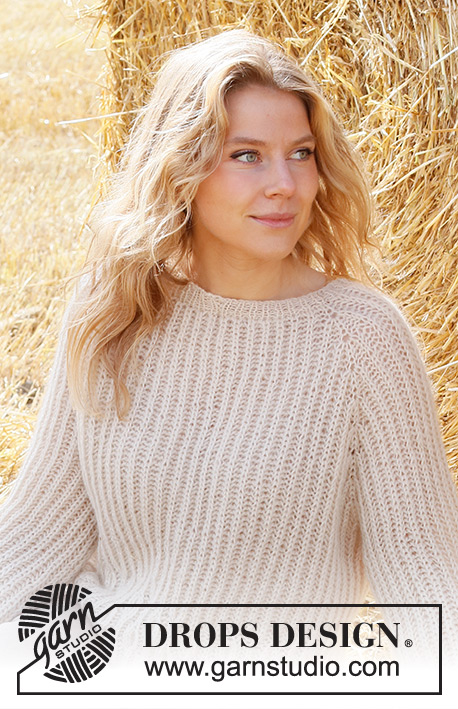



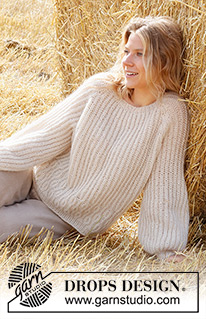

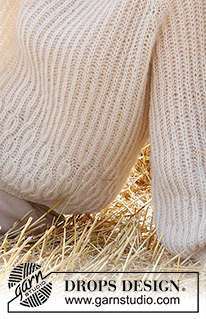











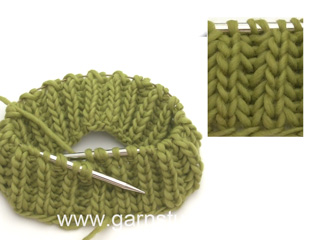
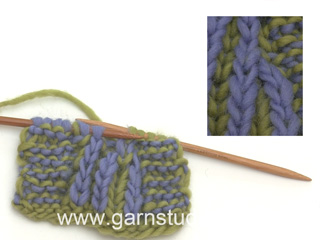


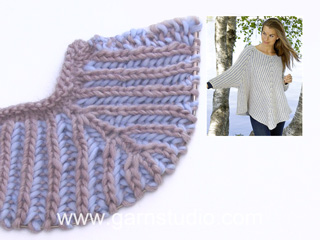






































Comments / Questions (39)
Hej Ökningen till raglan blir mycket snyggare om man gör en ökning på varje sida om markeringen vart fjärde varv istället. Plockar upp en maska i den som ska stickas rät, stickar den räta, plockar upp en maska ur bågen på den som ska stickas avig, gör omslag och lyfter. Andra ökningen får man då på en maska som ska stickas avig. Plocka en maska ur bågen, sticka nästa rät (fast den egentligen skulle vara avig), plocka upp en ur bågen på nästa, sticka den rät.
24.09.2021 - 12:59Hei igjen. Det har ikke blitt så pent så langt ettersom kastet da automatisk strekker seg over to masker. Kanskje jeg gjør det feil?
07.06.2021 - 13:30DROPS Design answered:
Hei Birgitte. Du avslutter 2. omgang med "lag 1 kast om pinnen, ta 1 maske løs av pinnen som om den skulle strikkes vrang" og starter 3 omg med "lag 1 kast om pinnen, ta 1 maske løs av pinnen som om den skulle strikkes vrang". Selv om du føler at kastet strekker seg over 2 masker har du 1 maske mellom disse to kastene. Vi skal prøve å lage en video der vi viser overgangen bedre. mvh DROPS design
07.06.2021 - 15:31Hei! Jeg er kun på første 3 omgang helpatent, men ser at det blir litt rart ved startmerket når det er 80 masker (eller uansett partall). Dersom omgangen slutter på kast vil neste omgang starte på kast. Er det noe triks jeg ikke har fått med meg eller skal det være en slags linje nedover ryggen?
06.06.2021 - 21:41DROPS Design answered:
Hei Birgitte. Selv om en omgang avslutter med "lag 1 kast om pinnen, ta 1 maske løs av pinnen som om den skulle strikkes vrang" og neste omgang starter med "lag 1 kast om pinnen, ta 1 maske løs av pinnen som om den skulle strikkes vrang", så vil det bli en pen overgang. mvh DROPS design
07.06.2021 - 12:05Hei Hvordan kan den 15. 10. 30. og 10. masken (XL) være den masken økningen til raglan skal foregå i? Det er jo i utgangspunktet en vrang patentmaske etter mønsteret og ikke en rett patentmaske slik raglanfellingen tilsier. Det er ingen sammenheng her. Takk
27.04.2021 - 12:11DROPS Design answered:
Hei Magdalena. Når du har satt merker i arbeidet etter å ha strikker 3. omgang første gang, gjentar du kun 2. og 3. omgang av Helpatent med kast. Når du da skal strikke 3. omgang for 2. gang starter økningene til raglan. Dette er da en omgang der det strikkes lag 1 kast om pinnen, ta 1 maske løs av pinnen som om den skulle strikkes vrang, strikk kastet og den løse masken rett sammen (her økes det). mvh DROPS design
03.05.2021 - 13:15Stickar storlek s och får 4 maskor ”över” i samband med övergången mellan halskant & oket. Stämmer mönstret?
04.04.2021 - 11:45DROPS Design answered:
Hej Carin. Har du sett att du minskar maskor i de rätstickade partierna under HALSKANT? Mvh DROPS Design
13.04.2021 - 08:58Findes der en oversigt over vanskelighedsgrad? Jeg synes, som begynder, det er svært at vide om opskriften er for svær for mig.
01.03.2021 - 04:11DROPS Design answered:
Hej Gro, du kan søge på "nybegynder" så vil du få de letteste opskrifter at vælge imellem :)
01.03.2021 - 14:50Vart är själva mönstret på svenska? Det är bara diagrammet som finns!
11.02.2021 - 20:34DROPS Design answered:
Hej Ann-Britt! Tack för info, nu finns mönstret även på svenska! Mvh DROPS Design
12.02.2021 - 13:58Hej! Jag kan inte se att det finns någon mönsterbeskrivning på Drops 223-15. Har kört ut beskrivningen men det verkar saknas? Med vänlig hälsning, Maritha Broman
05.02.2021 - 14:03Cornfields
16.01.2021 - 10:25Harvester's Dream
12.01.2021 - 10:40